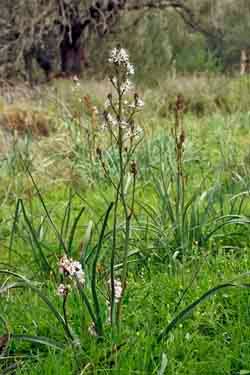The almond tree is the first to blossom, often as early as January. But while the anemones started blooming last November the almonds kept us waiting. They only now starting their metamorphosis into wonderful pink-white clouds. Vincent Van Gogh used to love almond blossoms and one of his well known paintings was done to celebrate the birth of his brother’s wife’s new baby. His almond branches are set against a stark blue sky and the flowers seem to be floating through heaven.
Here in the north of the island, after months of sunshine and warm temperatures, the weather has become more wintry: grey skies and a freezing north wind. As we walk under the almond trees we may miss Van Gogh’s bright blue sky against his delicate pink-white blossoms, but a grey sky can’t spoil the lightness you feel as you take in their fragrant sweet scent. It tells you spring will come soon. The almond tree stands for hope and it is an inspiration for nice stories.
One of the sons of Theseus was Demophon who fought together with all the other heroes and demi-gods at Troy. After the fighting, on his way home, he met the Thracian princess Phyllis. They fell in love but before they could marry Demophone had to go home and settle his affairs. And so Phyllis waited for his return. And she waited and waited. Some stories say that each day she went to the shore to look out for her lover, others say she waited before the family altar for him. She became more and more despairing and finally took her own life. The goddess Athena had mercy on her and transformed her into an almond tree. When Demophon finally returned to Thrace he found the almond tree. The story goes that the tree was barren of blossom but when Demophon embraced it, suddenly thousands of blossoms sprouted out of the branches.
In Portugal they also have a nice story about the almond tree: once upon a time a Moorish king married a Norwegian princess and they lived in the Algarve. However, the princess did not like the beautiful landscape with its singing birds and colourful flowers and was homesick for the cold and the snow of her own country. She became more and more depressed, would not leave the palace and even had all windows shut because she did not want to face the landscape anymore. However, early in March, the king ordered that all windows had to be opened and he made the princess look out. There she saw that everything had turned white – the entire landscape was covered by a layer of almond blossom. Her homesickness disappeared and from then on she and the king lived a long and happy life.
Walking through the ‘snowy’ landscape I have noticed that the almond blossom is not the only flower giving the landscape its spring-like look. The asphodels (Asphodelus aestivus) have also started to flower and from a distance the two look alike. However, there are many differences between them. The sea of almond blossoms seem to descend from the sky while the asphodels send their flowers from deep in the earth. While sweet scenting almond blossoms are like a gift from heaven, asphodels are said to come from the underworld of Hades. I once picked a bunch of these beautiful flowers, but never again – they do not smell nice!
Asphodels used to be planted around graves, as a reminder of the underworld, but I see them as harbingers of spring. They used to be a favourite flower of Persephone, daughter of Demeter, who was abducted by Hades and taken to the underworld. Many images of Persephone depict her with a garland of them around her head. Maybe the odour in the underworld is already so bad that you would not notice the asphodels. It’s a pity they have this sharp and bitter smell (which you have to be quite near to notice) because their white-rose flowers are as plentiful in the countryside as the almonds. The yellow species (Asphodeline lutea) is a popular flower in the gardens of western Europe, but here it’s the wild white variety which fills the fields here, giving us a view every bit as beautiful as the almond blossoms. It is a pity that they are so little appreciated.
The plant belongs to the lily family and grows from a bulb. You can’t miss them as they often reach as high as onemeter. Homer wrote of them as the flowers from the Underworld and Pliny advised they be planted in front of a country house to keep witches away. Theophrastus said the bulbs are good to eat – for example served with figs. They were cooked in warm ashes, sprinkled with a little salt and oil and it is said that they were also a favourite of Pythagoras. The pulp of the cooked bulbs was used to treat diseases of the joints and nerves, while fresh pulp was good to remove freckles and asphodel seeds marinated in wine were believed to be a remedy for snake and scorpion bites. So you could say it is a plant with many uses. Now they are in shadow of the almond blossoms, so typical of the early spring landscape, but alas almost forgotten.











